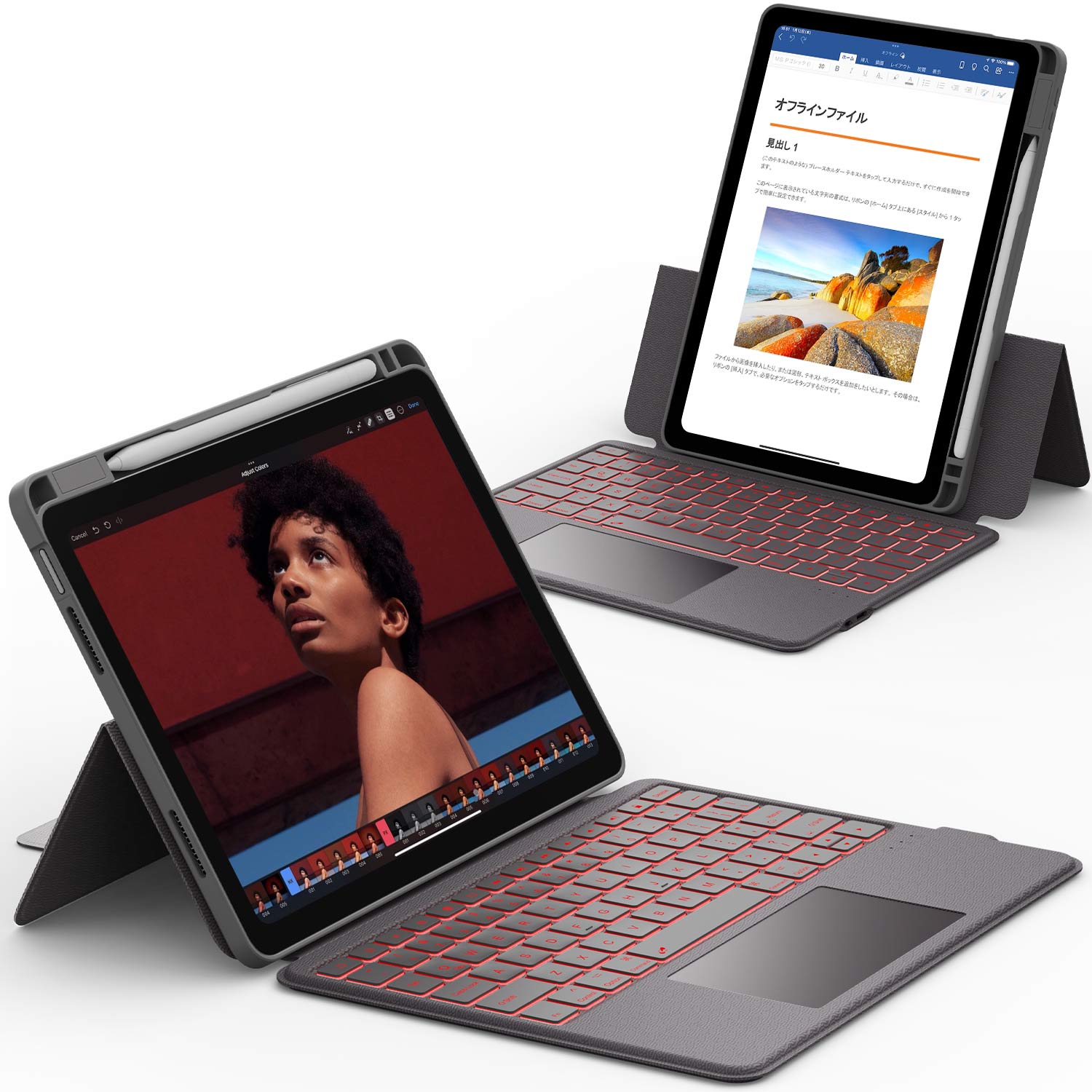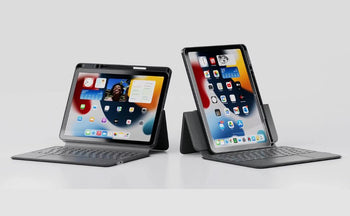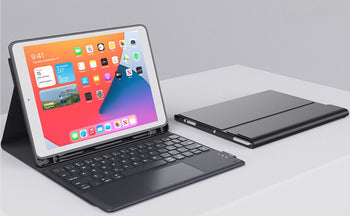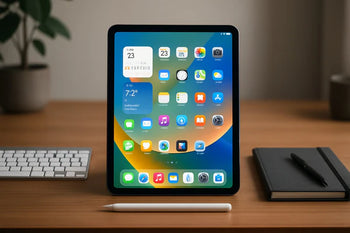Choosing between the iPad and iPad Air can feel tricky. They look almost the same, but honestly, they fit different needs.
The main difference? The iPad Air runs faster and packs more advanced features. The regular iPad offers solid everyday use for a lower price.
Knowing what sets them apart helps you spend wisely. You want the one that fits your lifestyle, not just the one that looks good.
If you just want a tablet for streaming, browsing, or light work, the iPad covers the basics. It doesn’t overcomplicate things.
But if you plan to use demanding apps, edit photos, or want to try the Apple Pencil Pro, the iPad Air’s M3 chip and added features make it a stronger pick.
Also learn more by reading our guide, How Many Generations of iPads Are There? Complete Guide by Model.
Key Differences Between iPad and iPad Air

The iPad and iPad Air look similar, and both run the same software. Still, they don’t perform the same, and they support different accessories.
The Air has a faster chip, better display, and works with newer accessories. The entry-level iPad sticks to value and basics.
Target Users and Use Cases
The entry-level iPad fits best for everyday stuff—browsing, streaming, note-taking. It’s a good pick for school, casual work, or just hanging out online without spending a fortune.
The iPad Air targets folks who need more power for creative or demanding tasks. Its M3 chip handles photo editing, design software, and multitasking way better than the iPad’s A16 chip.
If you want to use the Apple Pencil Pro or the Magic Keyboard, the Air supports both. The iPad only works with the basic Apple Pencil (USB-C) and standard keyboards.
|
Feature |
iPad (11th Gen, 2025) |
iPad Air (M3, 2025) |
|
Chip |
A16 |
M3 |
|
Display Sizes |
11" |
11" or 13" |
|
Pencil Support |
Apple Pencil (USB-C) |
Apple Pencil Pro |
|
Apple Intelligence |
Not Supported |
Supported |
Pricing and Value
The iPad starts at about $349, so it’s Apple’s most affordable tablet. You get 128GB of storage and good performance for the price.
It’s a solid choice if you want a simple, capable device for light work or family use.
The iPad Air starts at $599 for the 11-inch model and $799 for the 13-inch. You pay more, but you get faster performance, better accessories, and a nicer display.
Explore the iPad Pro 11-inch case with pencil holder for added convenience.
Design and Build Quality

Apple gives both the iPad and iPad Air a clean, modern look. But they don’t feel the same in your hands.
The Air feels thinner and lighter. The regular iPad keeps a slightly bulkier shape that feels sturdy and practical.
Size and Weight Comparison
The iPad Air comes in two sizes: 11‑inch and 13‑inch. Both are thinner and lighter than the basic iPad (10.9‑inch).
You’ll notice the difference if you hold your tablet for long stretches or toss it in your bag every day.
|
Model |
Display Size |
Thickness |
Weight |
|
iPad (10th gen) |
10.9 in |
7.0 mm |
~477 g |
|
iPad Air (11 in, M3) |
11 in |
6.1 mm |
~462 g |
|
iPad Air (13 in, M3) |
13 in |
6.1 mm |
~617 g |
The thinner edges on the iPad Air make it look a bit fancier. Smaller bezels give you more screen without extra bulk.
If you want something light but still solid, the Air’s design hits a sweet spot for portability and comfort.
Material and Color Options
Both models use recycled aluminum for the body. The iPad Air feels a little more premium because of its uniform edges and matte finish.
The regular iPad’s glossy finish doesn’t hide fingerprints as well. It’s a small thing, but you might notice it.
Color options are different, too. The iPad comes in Silver, Blue, Pink, and Yellow.
The iPad Air gives you Space Gray, Starlight, Blue, and Purple. The Air’s colors look more muted and professional, while the iPad’s are brighter and a bit more playful.
You can use Apple accessories like the Magic Keyboard or Smart Folio with either tablet. The Air’s slimmer frame fits these add-ons a bit better, though.
Get inspired with Best iPad Accessories Every iPad Owner Needs to make your device even more functional.
Display and Visual Experience

CHESONA ArmorDock Series Keyboard Case for iPad Pro 12.9" 6/5/4/3th
You’ll spot some clear differences in screen quality. The Air’s display looks sharper, brighter, and just feels higher-end, while the regular iPad keeps things simple and affordable.
Screen Size and Resolution
The iPad Air has a 10.9‑inch Liquid Retina display. The regular iPad uses a 10.2‑inch Retina display.
The Air’s screen is a little bigger, so you get more room for apps, videos, or multitasking.
Both look sharp, but the Air’s higher resolution—2360 x 1640 pixels—shows finer detail. The iPad’s 2160 x 1620 pixels is good, but not quite as crisp.
You’ll notice smoother text and clearer images on the Air, especially when reading or editing photos.
The Air’s thinner bezels add to that modern, immersive vibe. The iPad’s thicker borders look more classic, but they don’t get in the way for everyday use.
|
Model |
Screen Size |
Resolution |
Display Type |
|
iPad (10th Gen) |
10.2 inches |
2160 x 1620 |
Retina |
|
iPad Air (M2) |
10.9 inches |
2360 x 1640 |
Liquid Retina |
Display Technology and Features
The iPad Air uses a fully laminated display. The glass and screen are bonded together, so there’s no gap.
On the regular iPad, you might notice the display sits just below the glass. The Air feels like you’re touching the pixels directly.
The Air also has an anti‑reflective coating that cuts down glare. It’s easier to use in bright light.
The regular iPad doesn’t have this, so you’ll see more reflections outdoors or near windows.
Both support True Tone tech, which adjusts color temperature based on your lighting. Whites look natural, and your eyes don’t get tired as fast.
Color Gamut and Brightness
The iPad Air supports the P3 wide color gamut. You’ll see deeper reds, richer greens, and more accurate colors.
The regular iPad sticks to sRGB, so colors look good but not quite as vibrant or true-to-life.
This makes the Air better for creative work like photo editing or digital art, but the iPad still looks nice for movies and games.
The Air gets a bit brighter, too—about 500 nits compared to the iPad’s 460 nits. It’s a small bump, but you might notice it in sunlight.
Performance and Hardware
The iPad and iPad Air don’t just look different—they run at different speeds and handle tasks differently, especially if you push them hard.
Processor and Chipset
The iPad (11th generation, 2025) uses Apple’s A16 chip, the same one in the iPhone 14 Pro. It’s fast enough for normal stuff like browsing, streaming, and notes.
The A16 is about 30% faster than the old A14 Bionic chip, with better graphics, too.
The iPad Air (2025) runs on Apple’s M3 chip. It has an 8-core CPU and 9-core GPU, so it crushes creative apps, 3D work, and heavy multitasking.
If you edit photos, design, or play big games, the M3 feels much snappier. For basic stuff, the A16 is still plenty smooth.
|
Model |
Chip |
CPU |
GPU |
Ideal For |
|
iPad (11th Gen) |
A16 |
6-core |
5-core |
Everyday tasks |
|
iPad Air (2025) |
M3 |
8-core |
9-core |
Creative and intensive work |
RAM and Storage Options
The iPad gives you 128GB, 256GB, or 512GB storage. That’s more than enough for most people—think school, work, or just entertainment.
The iPad Air starts at 128GB and goes up to 1TB. If you keep big files or lots of apps, that extra space is nice.
The Air has 8GB of unified memory (RAM), so it runs more apps at once and handles big projects better.
If you mostly stream or use cloud storage, the iPad’s storage is fine. But if you need to save lots of media or work files, the Air’s bigger storage keeps you covered for longer.
Battery Life and Charging
Both iPad models claim up to 10 hours of web or video use over Wi‑Fi. You’ll get about the same battery life for movies or browsing.
The iPad Air’s M3 chip uses a more efficient design. This helps it hold up during heavier tasks without draining too fast.
Both charge through USB‑C. The Air supports faster USB‑C 3 transfer speeds, which is nice if you move big files.
Neither supports wireless charging, so you’ll still need a cable. Charging speed depends on the adapter, but you usually get about 50% charge in an hour.
Check out the iPad keyboard case with touchpad to boost your productivity.
Software and Features

CHESONA Rugged Series Keyboard Case for iPad Pro 12.9'' & Air 13'' (M2/ M3)
Both the iPad and iPad Air run the same iPadOS version and come with similar built‑in apps. The differences show up with performance, Apple Intelligence, and how each one handles multitasking or creative work.
Operating System and Updates
Both tablets use iPadOS 18. You get features like customizable widgets, better Notes tools, and a new Calculator that solves handwritten math.
The interface feels clean and simple, with smooth animations. Apple rolls out consistent updates for both models.
The iPad Air’s M3 chip gives it a boost for advanced system features and makes it more responsive. The standard iPad, with its A16 Bionic, still does fine for web browsing, streaming, and schoolwork, but it can feel a bit slower when you’re switching between heavy apps.
Apple usually supports iPads with updates for five to six years. Both models should stay current for quite a while, with security patches and new iPadOS versions landing at the same time.
Apple Intelligence and AI Capabilities
The iPad Air (2025) supports Apple Intelligence, Apple’s new AI tools in iPadOS 18. These include writing suggestions, smarter search, and image generation for creative work.
You can use Siri in a more conversational way and get context-aware help across apps. The iPad (11th generation) doesn’t support Apple Intelligence, since its A16 chip just isn’t up for it.
You’ll still get regular Siri, text suggestions, and dictation on the regular iPad, but not the fancy new AI features. If you do a lot of writing, research, or design, the iPad Air’s AI tools make things faster and more flexible.
Multitasking and Productivity Tools
Both models come with Stage Manager, Split View, and Slide Over for multitasking. You can run a couple of apps side by side or flip between them quickly.
The iPad Air feels smoother at this, thanks to its stronger processor and extra memory. You can connect a Magic Keyboard or trackpad to either tablet, turning it into a lightweight laptop.
The Air works with the newer Magic Keyboard, which has a function row and bigger trackpad for a comfier workspace. Both iPads handle note taking, video calls, and editing documents just fine.
Accessory Compatibility

CHESONA Step Series Keyboard Case for iPad Pro 11" 4th/3rd/2nd/1st Gen/Air 10.9"
Accessory support changes depending on if you pick the iPad or iPad Air. You’ll notice differences in which Apple Pencil versions, keyboards, and connectors work, which matters for school, work, or creative stuff.
Apple Pencil and Apple Pencil Pro Support
The standard iPad supports the Apple Pencil (1st generation). It connects through USB‑C or Lightning, depending on the year.
It doesn’t work with the newer Apple Pencil Pro or Apple Pencil (2nd generation). The iPad Air (M1, M2, and M3 models) supports the Apple Pencil (2nd generation) and Apple Pencil Pro.
These attach magnetically to the side and charge wirelessly. That makes pairing and charging way easier, plus it keeps your stylus from getting lost.
The Apple Pencil Pro adds squeeze gestures and haptic feedback, which the iPad Air can use but the regular iPad can’t. If you’re into drawing or taking notes, the iPad Air gives you more options and better stylus tech.
Magic Keyboard and Smart Connector
The Smart Connector sets the two models apart. This connector lets you attach keyboards without needing Bluetooth pairing.
The iPad Air has a Smart Connector on the back, so you can use the Magic Keyboard and Magic Keyboard Folio. These give you laptop-style typing and a trackpad, and they draw power right from the iPad.
The standard iPad works with the Magic Keyboard Folio, but not the full Magic Keyboard. It uses a side-mounted connector, which changes how the keyboard attaches.
If you type a lot or use your iPad for work, the iPad Air’s accessory options feel more flexible and advanced.
Other Accessories
Both iPads work with lots of Bluetooth accessories—wireless headphones, mice, keyboards, you name it. They also support USB‑C accessories, like hubs, drives, and displays.
The iPad Air’s faster chip and USB‑C speed make it better for things like external SSDs or 4K monitors. You can use cases, stands, and covers for each, but they aren’t interchangeable due to size differences.
Always check compatibility before buying to make sure your accessory fits and works right.
Discover practical insights in Is a Magnetic Case Good for an iPad? before choosing your next cover.
Connectivity and Ports

CHESONA Cloud Series Keyboard Case for iPad Pro 13'' (M4) 2024
Both iPads come with modern connectivity, but the Air has faster wireless options and a better USB-C port. These differences change how fast you can transfer files, connect accessories, or get online.
Wi-Fi and Bluetooth Capabilities
Both support Wi‑Fi 6, which means faster speeds and better streaming. The iPad Air (M3) goes further with Wi‑Fi 6E, giving you the 6GHz band for less network congestion.
If you use lots of wireless accessories, you’ll notice the difference in Bluetooth. The Air has Bluetooth 5.3, which connects stronger and uses less power. The regular iPad has Bluetooth 5.0 or later, which still works fine for most folks.
For most home networks, both work smoothly. But if you have a new router or lots of Bluetooth gadgets, the iPad Air’s connection just feels more reliable and faster.
USB-C and Other Ports
Apple now uses USB‑C ports on both iPads, ditching the old Lightning port. This makes charging and connecting accessories easier since USB‑C is everywhere now.
The iPad Air’s USB‑C port is faster and supports higher data transfer speeds. You can move big files—like 4K videos—in seconds.
The standard iPad’s port is slower but still works for charging and basic accessories. If you move files a lot, the Air’s USB‑C saves time and connects to external displays or cameras more easily.
Cellular and SIM Options
You can get a Wi‑Fi‑only or Wi‑Fi + Cellular version of either iPad. Cellular models use eSIM technology, so you don’t need a physical SIM card.
Some also support 5G for faster mobile internet. The iPad Air supports more 5G bands and does a bit better in areas with strong coverage.
The regular iPad still gives you solid LTE and 5G speeds for browsing or video calls. If you travel a lot or work away from Wi‑Fi, the cellular option is worth a look. You can switch carriers easily with eSIM and stay online almost anywhere.
Browse our iPad Air 11" cases for slim, stylish protection.
Camera and Audio Features

CHESONA Step Series Keyboard Case for iPad 11/10th Gen 10.9"
Both iPads have similar camera setups, but the Air has better image processing and display support for editing or streaming. You’ll see some differences in video calls and sound quality, especially when recording or watching stuff.
Rear and Front Camera Comparison
Both have a 12MP rear camera with f/1.8 aperture and Smart HDR 3 or 4. Photos look sharp, but the iPad Air’s M-series chip processes images faster and shows richer color.
The front camera on both is 12MP Ultra Wide with Center Stage. The iPad’s camera sits on the long edge, so your face stays centered during landscape calls.
The Air’s camera sits on the short edge, which can feel less natural with a keyboard case. If you take lots of photos, record clips, or join meetings, both work well, but the Air handles editing a bit smoother.
Center Stage and Video Features
Center Stage keeps you in the frame during calls. It works on both, but the iPad’s landscape camera makes it more practical for meetings or streaming.
You can record 4K video at 60 fps or 1080p at 60 fps on both. The Air’s M1 or M2 chip makes video editing in apps like iMovie or LumaFusion faster, with smoother playback.
Both support Smart HDR for video, so you keep detail in bright or dark spots. If you create content or stream, the Air’s extra power gives you a small but nice edge.
Speaker and Microphone Quality
The iPad and iPad Air both have stereo speakers. The Air sounds a bit fuller, especially when you watch movies in landscape mode.
Both have dual microphones for clearer voice pickup. The Air’s mics handle background noise a little better, which helps on calls or when recording.
If you use your tablet for video editing, streaming, or online classes, you’ll probably like the Air’s cleaner, more balanced sound.
Which Should You Choose?
If you want an Apple tablet for everyday use, the regular iPad gives you strong value. It handles web browsing, streaming, note-taking, and light gaming without trouble.
Its A16 chip feels fast for most things. The lower price makes it a good pick for students or families.
The iPad Air suits you better if you need more power. Its M3 chip runs demanding apps and advanced games more smoothly.
You’ll also get a brighter screen option and faster data transfer. It supports the Apple Pencil Pro, which helps if you draw or edit photos.
Here’s a quick comparison:
|
Feature |
iPad (11th Gen) |
iPad Air (M3, 2025) |
|
Starting Price |
$349 |
$599 |
|
Chip |
A16 |
M3 |
|
Screen Sizes |
11-inch |
11-inch or 13-inch |
|
Apple Pencil Support |
Pencil (USB‑C) or 1st Gen |
Pencil Pro |
|
Wi‑Fi |
6 |
6E |
|
Apple Intelligence |
No |
Yes |
If you mostly stream, browse, or play casual games, the iPad meets your needs. But if you edit videos, play high-end games, or want longer support for new features, the iPad Air is the smarter choice.
Bottomline
Understanding the difference between the iPad and iPad Air helps you choose the best device for your needs. The iPad offers great value for everyday use, while the iPad Air delivers enhanced performance and a lighter design for professionals and students.
Whether you’re using your iPad for work, creativity, or entertainment, protecting it is key. Explore CHESONA’s premium iPad cases and tablet cases designed for every model—built to combine durability, style, and smart functionality.
Check out CHESONA’s iPad cases today and give your device the protection it deserves!
Frequently Asked Questions
What are the main features that set the iPad Air apart from other iPad models?
The iPad Air comes with the Apple M1 or M2 chip (depends on the model), which means faster performance than the regular iPad. It also supports the second-generation Apple Pencil and Magic Keyboard.
You’ll find a USB-C port and a laminated display for better touch response and color accuracy.
Can you explain the differences in performance between the iPad and iPad Air?
The iPad Air runs on a more powerful M-series chip, while the standard iPad uses the A-series chip. The Air handles multitasking, gaming, and creative apps more smoothly.
You’ll see faster load times and better graphics performance on the Air, especially with demanding apps.
How does the battery life compare between the iPad Air and the regular iPad?
Both tablets offer about 10 hours of web browsing or video playback on Wi‑Fi. In everyday use, their battery life feels nearly the same.
The difference really depends on the apps you use and your screen brightness.
Are there any significant differences in display quality between the iPad and iPad Air?
The iPad Air has a 2360 x 1640 resolution display, while the standard iPad has 2160 x 1620. The Air’s screen is fully laminated and includes True Tone and wide color (P3) support, so it looks sharper and more vibrant.
The regular iPad’s non-laminated display can show slight gaps between the glass and pixels. If you’re picky about screens, you’ll probably notice.
In terms of design, what makes the iPad Air different from the standard iPad?
The iPad Air has a thinner bezel, flat-edge design, and a Touch ID button on the top. It’s lighter and looks more like the iPad Pro.
The standard iPad keeps the Home button and thicker borders, so it’s got more of that classic vibe.
What price differences should I expect when choosing between an iPad and an iPad Air?
The regular iPad usually starts around $300. The iPad Air, though, starts closer to $450–$500.
You’ll pay extra for a faster chip, a better display, and a lighter build. If you want more power for creative stuff or work, the Air’s higher price might actually feel worth it.



















